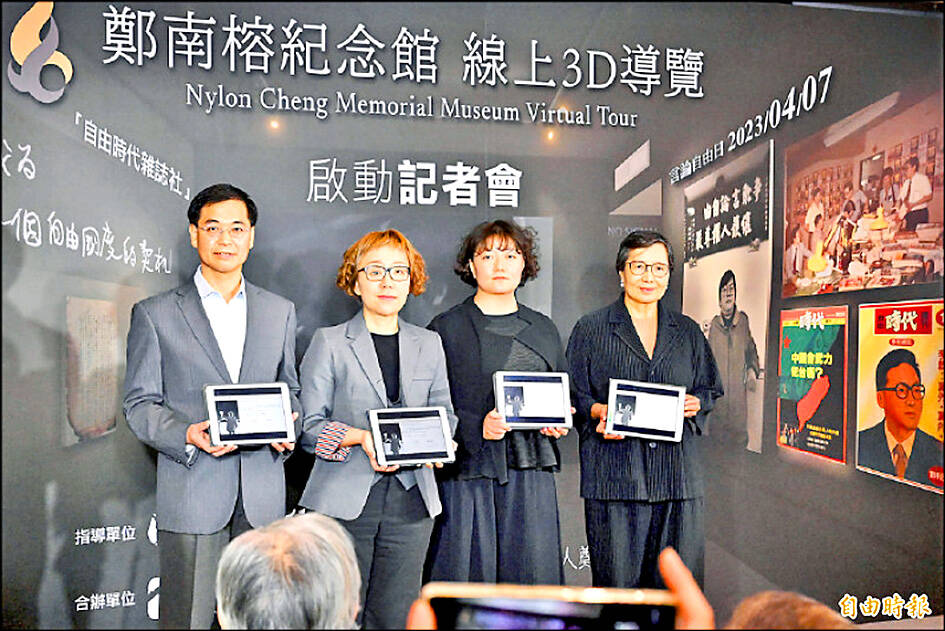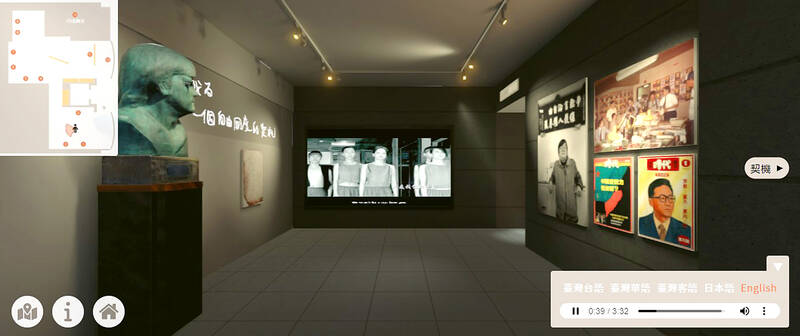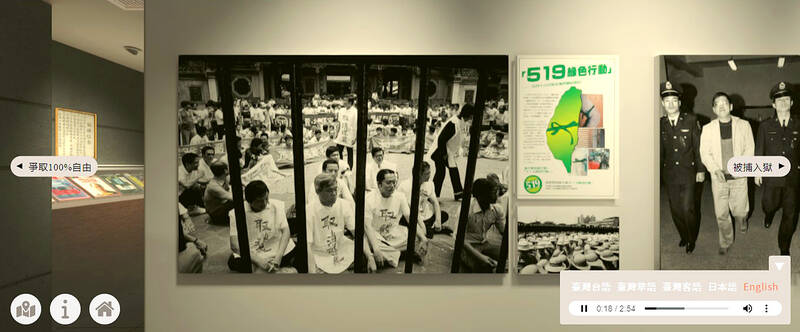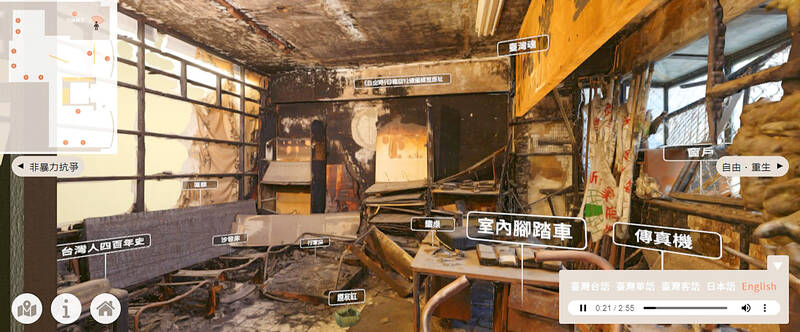There’s still no comparison between an online exhibition and visiting the actual space, but the gap is slowly narrowing — at least for information-based displays. Last Friday was Freedom of Speech Day (言論自由日) and to commemorate the occasion, the National Human Rights Museum (國家人權博物館) launched a 3D web museum dedicated to Deng Nan-jung (鄭南榕).
Deng, an outspoken proponent of freedom of expression, democracy and Taiwanese independence, self-immolated in his Freedom Era Weekly (自由時代) magazine office on April 7, 1989, just as the authorities and secret police were about arrest him for sedition. Although martial law had been lifted two years earlier, much of the government’s controls on society were still in place, and there was still a long way to go for Deng to achieve his goal of “100 percent freedom of speech.”
Regarding the museum, Deng’s widow and current presidential advisor Yeh Chu-lan (葉菊蘭) says she never thought that 34 years later, the destroyed magazine office that the authorities tried so hard to shut down would be seen by the world through the Internet.

Photo: Tsung Chang-chin, Taipei Times
“This piece of history needs to be told over and over to remind future generations how precious freedom is,” she said at a press conference on Thursday last week.
The online museum contains videos, pictures, art and artifacts detailing Deng’s life and ideals, reminding viewers of how grim things were just three decades ago and how far people would go to resist authoritarianism. The entire exhibition is in Chinese, but there’s an informative audio guided tour in Mandarin, Hoklo (commonly known as Taiwanese), Hakka, Japanese and English. I didn’t expect the detailed stories behind every displayed object to be translated into English, but organizers could have at least translated the titles into English.
As usual, navigating the space with a mouse and keyboard is the biggest obstacle. It’s better than many online exhibitions I’ve seen, but it’s still a bit clunky and hard to move around easily, especially since the space is quite cramped. The 3D modeling is detailed and well-done, however, and the exhibition route is intuitively designed. One problem is that it seems to be impossible to turn off the music.

Photo: Screenshots of vitrual museum
It’s much easier just to follow the guided tour, which takes about 50 minutes. Most striking are the charred remains of Deng’s office, where one can click on various surviving objects and learn about their significance. For example, he swapped his wooden table for a metal one at one point to prevent the fire from spreading, and also obtained a stationary bicycle so he could exercise during the 71 days he barricaded himself indoors to avoid arrest.
In addition to the main events in Deng’s life, the guide also provides historical context and connects the events to the present. Although today people can freely discuss their political positions and criticize the government, Taiwan is often censored on the international stage and its existence denied due to pressure from China.
“Some Taiwanese self-censor at home, others struggle to articulate who we are when we’re abroad,” the guide says.

Photo: Screenshots of vitrual museum
How to prevent and handle disinformation remains a major issue, and many problems remain regarding diversity, equality, justice and human rights. The exhibition leaves viewers with Deng’s last words: “What is left is up to you all.”
The physical museum is located at former magazine headquarters at 3F, 11, Ln 106, Alley 3, Minquan E Rd Sec 3, Taipei City (台北市民權東路三段106巷11號3F).
TAINAN EVENTS

Photo: Screenshots of vitrual museum
‧ Tainan City was the first to designate April 7 as Freedom of Speech Day in 2012, five years before it became a national observance. The city will be holding a series of events to commemorate the occasion.
‧ An art exhibition dedicated to Deng will run until Sunday at Punplace (胖地, 21 Nanmen Road, Tainan City, 台南市南門路21號) and surrounding stores, and there will also be displays at Tainan Cultural and Creative Park (臺南文化創意產業園區) until May 21.

June 2 to June 8 Taiwan’s woodcutters believe that if they see even one speck of red in their cooked rice, no matter how small, an accident is going to happen. Peng Chin-tian (彭錦田) swears that this has proven to be true at every stop during his decades-long career in the logging industry. Along with mining, timber harvesting was once considered the most dangerous profession in Taiwan. Not only were mishaps common during all stages of processing, it was difficult to transport the injured to get medical treatment. Many died during the arduous journey. Peng recounts some of his accidents in

“Why does Taiwan identity decline?”a group of researchers lead by University of Nevada political scientist Austin Wang (王宏恩) asked in a recent paper. After all, it is not difficult to explain the rise in Taiwanese identity after the early 1990s. But no model predicted its decline during the 2016-2018 period, they say. After testing various alternative explanations, Wang et al argue that the fall-off in Taiwanese identity during that period is related to voter hedging based on the performance of the Democratic Progressive Party (DPP). Since the DPP is perceived as the guardian of Taiwan identity, when it performs well,

The Taiwan People’s Party (TPP) on May 18 held a rally in Taichung to mark the anniversary of President William Lai’s (賴清德) inauguration on May 20. The title of the rally could be loosely translated to “May 18 recall fraudulent goods” (518退貨ㄌㄨㄚˋ!). Unlike in English, where the terms are the same, “recall” (退貨) in this context refers to product recalls due to damaged, defective or fraudulent merchandise, not the political recalls (罷免) currently dominating the headlines. I attended the rally to determine if the impression was correct that the TPP under party Chairman Huang Kuo-Chang (黃國昌) had little of a

At Computex 2025, Nvidia CEO Jensen Huang (黃仁勳) urged the government to subsidize AI. “All schools in Taiwan must integrate AI into their curricula,” he declared. A few months earlier, he said, “If I were a student today, I’d immediately start using tools like ChatGPT, Gemini Pro and Grok to learn, write and accelerate my thinking.” Huang sees the AI-bullet train leaving the station. And as one of its drivers, he’s worried about youth not getting on board — bad for their careers, and bad for his workforce. As a semiconductor supply-chain powerhouse and AI hub wannabe, Taiwan is seeing